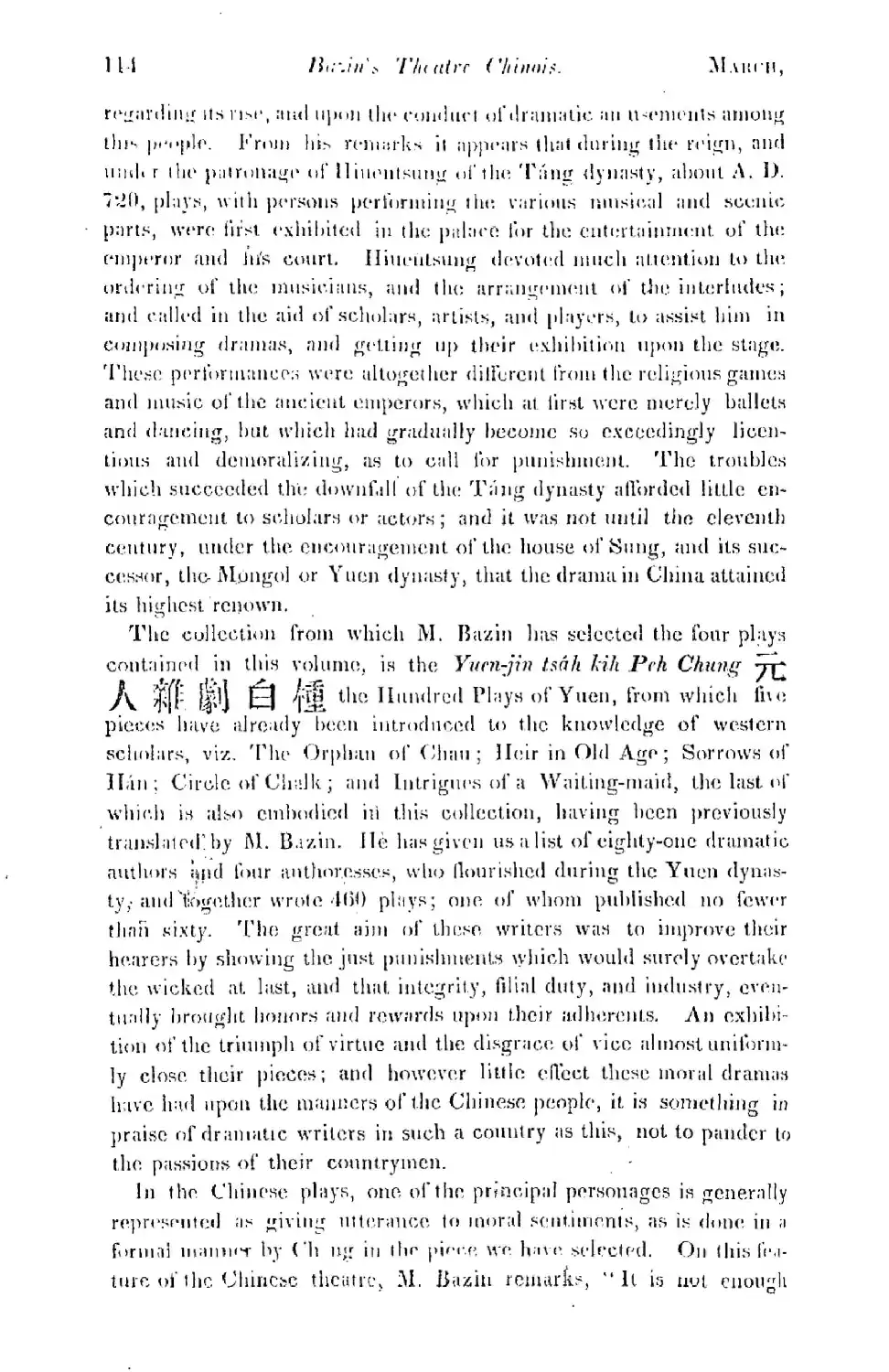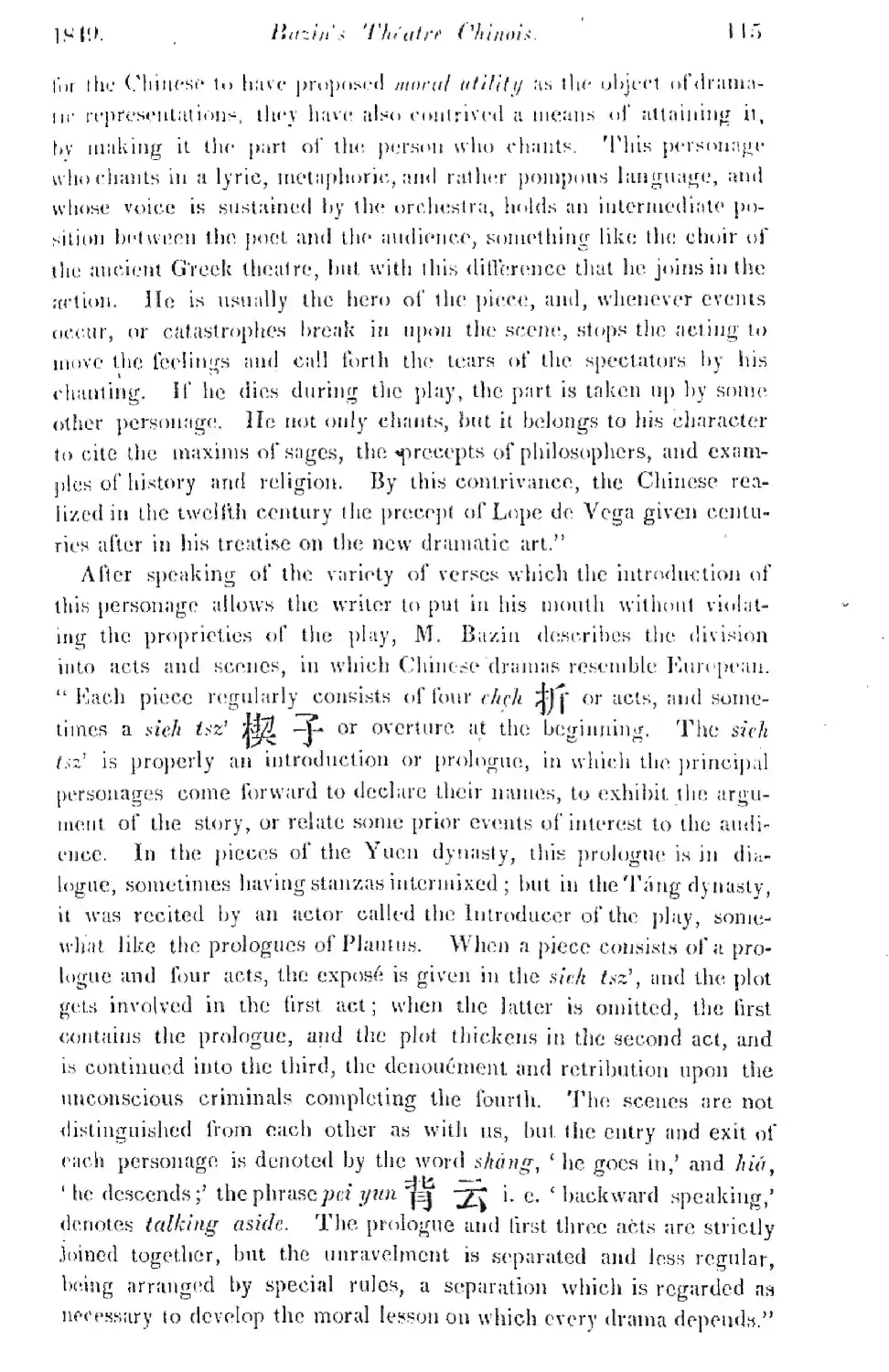The Chinese Repository, Volume 18 (January 1849)
- Info
- Pages
- Transcript
- Related
ART. I. Théatre Chinois, ou Choix de Pièces de Théatre composées sous
les empereurs Mongols. Traduites pour la première fois par M. Bazin
ainé. Paris, à I’Imprimerie Royale, 1838. pp. 409.
THE labors of French sinologues in the wide range of Chinese literature
are worthy of high praise, and contrast strongly with the meagre efforts
of English and American scholars in the same field; when too, the
commerce of France with China, and its citizens resorting here, are so
small and few in comparison with that of the other two nations. This
attention has been owing in great measure to the fostering aid of the
French government from the days of Louis XIV., and the facilities which
the rich collection of Chinese books now in the Bibliothèque Royale
still afford to the prosecution of these studies. The existence of such
a collection in a literary city like Paris naturally suggests the wish
to know something of its contents, and the example of a few enterprising
scholars, like Fourmont, Rémusat, and St. Martin, has inspirited others
to emulate their energy, correct their mistakes, and extend the bounds
of knowledge still farther into these little known regions.
The work here quoted is an instance of the results of this laudable and
pacific ambition to excel in the republic of letters, and we are much
indebted to the amiable and learned author for the pleasure he has
afforded us by his Théatre Chinois. The value of the work is enhanced by
the Introduction, in which M. Bazin has entered into a history of the
Chinese drama, and collected much curious information regarding its
rise, and upon the conduct of dramatic amusements among this people.
From his remarks it appears that during the reign, and under the
patronage of Hiuentsung of the Táng dynasty, about A. D. 720, plays,
with persons performing the various musical and scenic parts, were first
exhibited in the palace for the entertainment of the emperor and his
court. Hiuentsung devoted much attention to the ordering of the
musicians, and the arrangement of the interludes; and called in the aid
of scholars, artists, and players, to assist him in composing dramas,
and getting up their exhibition upon the stage. These performances were
altogether different from the religious games and music of the ancient
emperors, which at first were merely ballets and dancing, but which had
gradually become so exceedingly licentious and demoralizing, as to call
for punishment. The troubles which succeeded the downfall of the Táng
dynasty afforded little encouragement to scholars or actors; and it was
not until the eleventh century, under the encouragement of the house of
Sung, and its successor, the Mongol or Yuen dynasty, that the drama in
China attained its highest renown.
The collection from which M. Bazin has selected the four plays contained
in this volume, is the Yuen-jin tsáh kih Peh Chung 元人雜劇白種 the
Hundred Plays of Yuen, from which five pieces have already been
introduced to the knowledge of western scholars, viz. The Orphan of
Chau; Heir in Old Age; Sorrows of Han; Circle of Chalk; and Intrigues of
a Waiting-maid, the last of which is also embodied in this collection,
having been previously translated by M. Bazin. He has given us a list of
eighty-one dramatic authors and four authoresses, who flourished during
the Yuen dynasty, and together wrote 460 plays; one of whom published no
fewer than sixty. The great aim of these writers was to improve their
hearers by showing the just punishments which would surely overtake the
wicked at last, and that integrity, filial duty, and industry,
eventually brought honors and rewards upon their adherents. An
exhibition of the triumph of virtue and the disgrace of vice almost
uniformly close their pieces; and however little effect these moral
dramas have had upon the manners of the Chinese people, it is something
in praise of dramatic writers in such a country as this, not to pander
to the passions of their countrymen.
In the Chinese plays, one of the principal personages is generally
represented as giving utterance to moral sentiments, as is done in a
formal manner by Cháng in the piece we have selected. On this feature of
the Chinese theatre, M. Bazin remarks, “It is not enough for the Chinese
to have proposed moral utility as the object of dramatic
representations, they have also contrived a means of attaining it, by
making it the part of the person who chants. This personage who chants
in a lyric, metaphoric, and rather pompous language, and whose voice is
sustained by the orchestra, holds an intermediate position between the
poet and the audience, something like the choir of the ancient Greek
theatre, but with this difference that he joins in the action. He is
usually the hero of the piece, and, whenever events occur, or
catastrophes break in upon the scene, stops the acting to move the
feelings and call forth the tears of the spectators by his chanting. If
he dies during the play, the part is taken up by some other personage.
He not only chants, but it belongs to his character to cite the maxims
of sages, the precepts of philosophers, and examples of history and
religion. By this contrivance, the Chinese realized in the twelfth
century the precept of Lope de Vega given centuries after in his
treatise on the new dramatic art.”
After speaking of the variety of verses which the introduction of this
personage allows the writer to put in his mouth without violating the
proprieties of the play, M. Bazin describes the division into acts and
scenes, in which Chinese dramas resemble European. “Each piece regularly
consists of four cheh 折 or acts, and sometimes a sieh tsz’ 楔子 or
overture at the beginning. The sieh tsz’ is properly an introduction or
prologue, in which the principal personages come forward to declare
their names, to exhibit the argument of the story, or relate some prior
events of interest to the audience. In the pieces of the Yuen dynasty,
this prologue is in dialogue, sometimes having stanzas intermixed; but
in the Táng dynasty, it was recited by an actor called the Introducer of
the play, somewhat like the prologues of Plautus. When a piece consists
of' a prologue and four acts, the exposé is given in the sieh tsz’, and
the plot gets involved in the first act; when the latter is omitted, the
first contains the prologue, and the plot thickens in the second act,
and is continued into the third, the denouément and retribution upon the
unconscious criminals completing the fourth. The scenes are not
distinguished from each other as with us, but the entry and exit of each
personage is denoted by the word sháng, ‘he goes in,’ and hiá, ‘he
descends;’ the phrase pei yun 背云 i.e. ‘backward speaking,’ denotes
talking aside. The prologue and first three acts are strictly joined
together, but the unravelment is separated and less regular, being
arranged by special rules, a separation which is regarded as necessary
to develop the moral on which every drama depends.”
The remarks will serve to introduce the drama we have selected from the
four contained in the Théatre Chinois; it is called the Compared Tunic,
and was written by Cháng Kwohpin, a clever woman of the 13th century.
The chief objects of the play are to enforce the practice of filial
piety, and show the detection and punishment of a villain; subordinate
to this are seen the rewards of assisting the poor, and the oversight
which superior powers take of the good and merciful.



